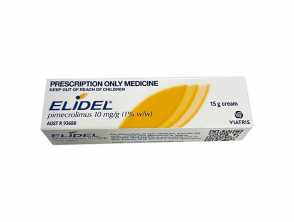What is pimecrolimus?
Pimecrolimus is a topical steroid-free medication with immune-modulating and anti-inflammatory properties, used to treat atopic dermatitis.
It is classified as a calcineurin inhibitor and an ascomycin macrolactam derivative; ascomycin is produced by Streptomyces hygroscopicus.
Pimecrolimus
What is pimecrolimus used for?
Pimecrolimus is approved for the short-term and intermittent long-term treatment of atopic dermatitis in patients who are over 3 months of age where topical corticosteroids are deemed inappropriate. In some countries, such as the United States, it is only approved for use in those over 2 years old. It provides a steroid-free alternative for helping control the itching and inflammation caused by atopic dermatitis.
Pimecrolimus cream may be useful in many other inflammatory skin conditions that respond to topical steroids. For example, it is used off-license for facial, flexural, or genital psoriasis. There is a growing body of evidence for the use of pimecrolimus cream in other skin conditions, on the specialist advice of a dermatologist.
How does pimecrolimus work?
The following immune-modulating effects have been noticed:
- Pimecrolimus at very small concentrations binds with high affinity to the protein receptor macrophilin-12 (FKBP-12).
- This resulting drug-protein complex inhibits calcineurin (a calcium-dependent phosphatase-transmitting chemical) which results in the blockage of signal transduction in target cells.
- As a consequence, the release of cytokines (chemicals in the body's immune system that can cause inflammation, redness, and itching) from T-cells and mast cells is blocked.
What are the contraindications of pimecrolimus?
Contraindications
- Known hypersensitivity to pimecrolimus or other macrolactams.
Precautions
- Increased risk of local skin infections — if infection develops, consider antimicrobials and stop pimecrolimus until the infection has resolved.
- UV light exposure — avoid excessive exposure to sunlight and sunlamps.
- Alcohol consumption — may cause facial flushing and skin irritation.
- Avoid use in areas affected by active cutaneous viral infections such as herpes simplex, molluscum contagiosum, or viral warts.
- Should not be applied to potentially malignant or premalignant skin lesions.
- Not recommended in patients with Netherton syndrome or severely inflamed or damaged skin (eg, erythroderma).
- Not recommended in immunocompromised patients, as the use of pimecrolimus in these patients has not been studied.
Pregnancy and breastfeeding
- Manufacturer advises avoid in pregnancy due to limited data in humans. Some reproductive toxicity has been demonstrated in animal studies following systemic (oral) administration, but not with topical application.
- Manufacturer advises caution in breastfeeding due to limited data, and that the cream should not be applied to the breast in breastfeeding mothers.
Application of pimecrolimus
Pimecrolimus cream is a prescription medicine and should be used only as directed by your doctor. Pimecrolimus cream may be applied to all skin surfaces including the head, face, neck, around the eyes, and skin folds.
- Rub a thin layer gently and completely into the affected area(s) twice daily.
- Do not use occlusive dressings eg, sticking plaster, paste bandages, or polythene film
- Wash hands after application if hands are not the treatment sites, or if you are applying the cream to someone else.
- Minimise or avoid exposure to natural or artificial sunlight.
- Emollients can be applied immediately after using pimecrolimus cream, unless after a bath or shower, in which case emollients should be applied before.
- Stop using pimecrolimus cream once signs or symptoms resolve. Use an emollient as maintenance therapy. Sometimes pimecrolimus is used twice weekly as an additional maintenance therapy. Restart daily pimecrolimus treatment when symptoms recur.
- If the condition does not improve within 6 weeks of treatment or at any time if the condition worsens, stop applying pimecrolimus cream and seek medical advice. It may be necessary to use a topical corticosteroid for a short course to control a flare of eczema.
What are the benefits of pimecrolimus?
- Pimecrolimus cream is odour-free, non-greasy, and absorbs quickly into the skin so it shouldn't stain clothes or bedding.
- Most patients tolerate pimecrolimus cream well.
- The risk of systemic side effects and skin atrophy, problems associated with the use of topical corticosteroids, has not been found with pimecrolimus use.
What are the side effects and risks of pimecrolimus?
| Frequency | Side effect |
| Very common |
|
|
Common |
|
|
Uncommon |
|
|
Rare |
|
|
Very rare |
|
There have been some reports of skin cancer and lymphoma in patients treated with pimecrolimus cream. However, a causal relationship has not been established. A recent meta-analysis showed evidence with moderate certainty that calcineurin inhibitors do not increase the risk of cancer.
We suggest you refer to your national drug approval agency such as the Australian Therapeutic Goods Administration (TGA), US Food and Drug Administration (FDA), UK Medicines and Healthcare products regulatory agency (MHRA) / emc, and NZ Medsafe, or a national or state-approved formulary eg, the New Zealand Formulary (NZF) and New Zealand Formulary for Children (NZFC) and the British National Formulary (BNF) and British National Formulary for Children (BNFC).
